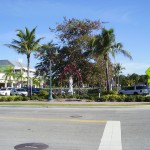Florida 2009
Frisked, frisked and frisked again
In November I had the brilliant idea of going to Florida for 10 days after Christmas, to escape from the dreadful English weather. It would be my 19th holiday in the United States and 13th trip to Florida, so I thought it would be a fairly mundane experience, not worth writing a book about.
The departure date was to be 27th December, and a few weeks earlier I booked the flight, car, insurance and a few hotel nights on the internet. The flight was with US Airways, which I knew was not the world's best airline, but I wanted to go from Gatwick and they had the best combination of flight and schedules.
The arrangements were threatened by the weather, because in the days before Christmas Gatwick was closed several times due to snow, but that was sorted out by Boxing Day. On Boxing Day evening a friend rang to say that I was going to have a lot of trouble due to new security rules for flights to the USA, following an attempt by a young Nigerian to blow up a jumbo jet on a flight to Detroit.
With this in mind I arrived at Gatwick four hours before my flight, and was able to check in straight away with no queue. In the normal security area the procedure was as usual and quite quick, again with no queue. I was frisked but that often happens anyway. However, I was told to be at the departure gate two hours before the plane was due to leave instead of the usual 30min. They had set up an extra security check in the departure lounge. Fortunately I got there early, but still had to queue for 30min. They had two lines, with the women and children on the left and the men on the right. There were two women with tables checking the people on the left and two men on the right. We had to empty the contents of our pockets and bags onto the table, remove our shoes, belts, etc and were thoroughly frisked again. All this was in full view of the waiting passengers, and I felt very ashamed when the man, who looked like a chartered accountant, took my camera out of its case and held it up. It is about three times as thick as a modern one and had a large figure 3 on it for 3 megapixels. Obviously people would think I couldn't afford a better one.
The queue gradually got longer and longer and how they managed to deal with everybody I do not know, but the plane took off on time. About two hours before we arrived in Charlotte there was an announcement "Ladies and gentlemen. A new rule has just come into force. For the last hour of the flight you must remain seated with your hands visible." So we sat there like naughty school children, and about half an hour before we were due to land there was a further announcement. "Ladies and gentlemen. Another new rule has just come into force. As you exit the aircraft you must hold your passport open at the photo page for examination by officers of the Department of Home Security." Sure enough, just outside the door there were three men dressed in flash uniforms who looked at our passports.
The scene in the immigration hall was horrific. Presumably due to the disruption several jumbo jets had arrived close together, and the queues were massive. They had 16 gates open, and the immigration procedure was the same as usual, but it took 75min to get to the desk, simply because of the number of people. At this point it is important to appear calm and well-disposed towards the United States, whatever you might actually be thinking. There was a problem with my fingerprints, which never come out well after years of burning my fingers making thermocouples, and the officer scrutinised one of my thumbs closely. He said he had spent some time in Oxford, which was a great place, and wished me a good holiday.
After collecting and rechecking my case for the flight to Tampa I had to queue for security again, shoes off, belt and 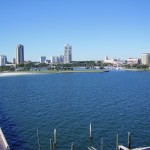 watch off, and was frisked again. Originally I had had 2½ hours for the connection and I finished up running to the gate with my shoelaces undone and got there with 2 min to spare.
watch off, and was frisked again. Originally I had had 2½ hours for the connection and I finished up running to the gate with my shoelaces undone and got there with 2 min to spare.
After all that I arrived at Tampa on time, picked up my car, a Kia Rio with 6 miles on the clock from new, and drove 300 yards down the road to the pretentiously named La Quinta Inn.
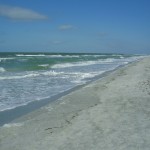 Over the next 2 days I gradually worked my way down the west coast, looking at St.Petersburg, various beaches and other old haunts. This entailed crossing the Sunshine Skyway bridge, which I always find slightly unnerving, but it is better since they removed the remains of the old bridge below on which several people were killed when it was hit by a ship. The weather was cold to start with but it gradually warmed up and went into the 60s during the day.
Over the next 2 days I gradually worked my way down the west coast, looking at St.Petersburg, various beaches and other old haunts. This entailed crossing the Sunshine Skyway bridge, which I always find slightly unnerving, but it is better since they removed the remains of the old bridge below on which several people were killed when it was hit by a ship. The weather was cold to start with but it gradually warmed up and went into the 60s during the day.
On the 3rd day it was much warmer and rose to well into the 70s. I started off at St. Armand's Circle, an upmarket shopping area where all I could afford was a cup of coffee, and spent the rest of the day on various beaches.
My next port of call was the strange town of Rotonda, which I had never seen. As the name suggests, it was originally built in a circle, or rather, in the form of a disc about 3 miles in diameter, with eight sectors, seven of which were built up and the remaining one was left to nature. The sectors are separated by canals, and each sector has its own golf course, the idea being that the residents could play on a different course every day of the week. As you enter you are greeted by a sign 'ROTONDA - A Deed-restricted Community'. There are 2 quite narrow single-carriageway ring roads, separated by a canal, and a dual carriageway across the middle east to west. I drove a quarter of the way round the inner ring and then across the middle. The entire town consists of detached bungalows, with no shops, schools, doctors or other public building within the circle, although I passed 2 deserted golf courses. I saw about 6 cars and otherwise no people at all. Apart from age, what sort of deed you would have to have to live in Rotonda I do not know, but two things come to mind - a low golf handicap or a certificate to say that you have totally lost the will to live. The ability to use a compass would also be useful. The town has since been greatly extended outside the original circle, and can be viewed in all its glory by putting Rotonda Florida into Google maps.
The temperature was still in the 70s, and later in the day it was my intention to go across to Fort Myers beach. However, at holiday time it is impossible to get there unless you go early, and after queuing for some time I gave up and looked for somewhere else to go. I saw signs to Koreshan State Park, Historical Site, and went down to have a look. It turned out to be a nature reserve on the site of a former religious settlement whose members gradually died out and left their property to the state. There were several marked trails including one leading to a river that I decided to 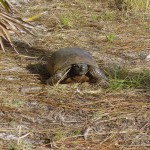 follow. After a few hundred yards, to my amazement, I came up behind a giant tortoise just wandering along the track, which at least proved that I can still walk faster than a tortoise. It was not on a par with the ones on the Galapagos Islands, but was about 12 inches long. Just as I started to take photographs a couple with a dog on a lead came along. I pointed at the tortoise and said "Look! Look!". The man said "Yeah, there's lots of 'em", which rather destroyed my hopes of becoming recognised as a 21st century Darwin. As I photographed it the tortoise came towards me, and when I reached out to it it hissed and pulled its head in. However when I scratched the top of its shell gently the head came out again and it seemed quite happy. The whole idea of wild tortoises seems rather strange to me, and I cannot imagine that they would last long in Britain before being taken as pets.
follow. After a few hundred yards, to my amazement, I came up behind a giant tortoise just wandering along the track, which at least proved that I can still walk faster than a tortoise. It was not on a par with the ones on the Galapagos Islands, but was about 12 inches long. Just as I started to take photographs a couple with a dog on a lead came along. I pointed at the tortoise and said "Look! Look!". The man said "Yeah, there's lots of 'em", which rather destroyed my hopes of becoming recognised as a 21st century Darwin. As I photographed it the tortoise came towards me, and when I reached out to it it hissed and pulled its head in. However when I scratched the top of its shell gently the head came out again and it seemed quite happy. The whole idea of wild tortoises seems rather strange to me, and I cannot imagine that they would last long in Britain before being taken as pets.
On the way back the tortoise had returned to its nest or wherever wild tortoises go when they are fed up with wandering about, but, although I couldn't see anything, I had a feeling that I was gradually being eaten. My fears were confirmed as I drove away when I saw a notice at the roadside advertising NOSEEUM SCREENS. I didn't seeum, but the next day I certainly feltum.
The following day was spent in Naples, a very upmarket town with a nice beach. The day started warm but overcast, and mid-morning I went through to the beach and walked along to the wooden fishing pier. When I got about as far from the car as I could walk the wind suddenly came up, the rain came down, the temperature dropped and I was 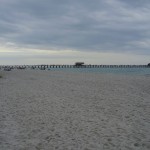 stuck for ages in the entrance of a toilet block until the deluge slackened off. Eventually I struggled back to the car, cold and wet, and went to the Coastland Shopping Mall to warm up. That was the only bad weather I saw in the States, but after that the temperature did not go back above the mid-60s.
stuck for ages in the entrance of a toilet block until the deluge slackened off. Eventually I struggled back to the car, cold and wet, and went to the Coastland Shopping Mall to warm up. That was the only bad weather I saw in the States, but after that the temperature did not go back above the mid-60s.
Originally I had not intended to go across to the east coast, but there were a number of places in the North Miami and Fort Lauderdale area that I used to know well and had not seen for years, so I decided to drive straight across through the Everglades on the toll road known as Alligator Alley. It is 84 miles long and the toll is $2.50 (£1.56). Compare that with France.
My first stop in Fort Lauderdale was Henn's T-Bird Swap Shop, which belongs to the quaintly named Preston Henn (it is ok for me to comment on other people's funny names). It is a vast market and boot sale, open 7 days a week, and in the evening it turns into a 14-screen drive-in movie theatre. Mr. Henn's hobby is motor racing and he has a collection of about 12 cars almost all with a top speed of over 200mph. Mainly Ferraris, but a recent addition is a Bugatti Veyron, made by Volkswagen, with 1001bhp and a claimed top speed of 253mph. Most of the cars are on display in the Swap Shop. Mr.Henn is a reasonably competent driver, but on the whole I think he is better at making the money to buy the cars than driving them. The Veyron is £839,000 in Britain.
After booking in at my motel I drove down to Hollywood, a seaside town with a very long paved promenade on which 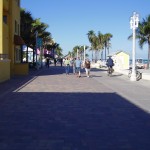 people do nearly everything you could possibly do on a promenade. There are people walking, running, cycling, skating, driving 4-wheeled pedal cars, but skate-boarding is not allowed.
people do nearly everything you could possibly do on a promenade. There are people walking, running, cycling, skating, driving 4-wheeled pedal cars, but skate-boarding is not allowed.
A few miles south of Hollywood is Sunny Isles, a part of North Miami Beach where I was stuck for four days many years ago because I had forgotten my driving licence and had to have it sent from England. In those days there was a row of 2-storey motels along the beach, built in the 1950s and 60s, many of them with dramatic architecture fronting the road. Sadly these have almost all gone, and been replaced with 40- and 50-storey skyscraper blocks, reputedly built by Donald Trump. The area was always very multi-cultural, with elderly German Jews, Hispanics, French Canadians and British people on holiday. This time I stopped in a shopping mall to have a look round, and saw a bookshop, of which there don't seem to be many left in Florida. I wandered in, and was astonished to find that all the books were in Russian, including many Mills and Boon style novels with pictures on the front just like the English ones. Apparently the area is now known as Little Moscow. When I got back to my motel in Fort Lauderdale I found in my room three telephone directories, the usual Gideon Bible, and a serious-looking hardback book in Russian. From the format it was not a bible, but it did not look like light reading.
Another victim of the Sunny Isles development was Wolfie Cohen's Rascal House, a Jewish restaurant that had a wide following amongst the general population and every evening there would be a long queue of people in the street outside waiting for seats. It has always amazed me how Americans will queue for an hour to get a seat in a restaurant that they like. As an eat to live person I would rather get something quickly in McDonald's next door and get on with my life, even though it might be a bit shorter as a result.
The wealth of southern Florida, both east and west, is hard to take in. As you drive northwards from Fort Lauderdale to Palm Beach there are miles of huge waterfront homes, many of them with correspondingly large yachts on the Intracoastal Waterway and marine developments extending inland along canals. There are similar upmarket residential areas on the other coast extending from Sarasota to Naples.
The area has not been immune to the recession, however. The realtors in Naples have lots of $1- $3million (£700,000 to £2,000,000) properties, but at the same time there are long lists of 'bank owned' (repossessed) condominiums and houses in the range $85,000 to $200,000. Houses are far cheaper than they are here, and for $200,000 (£125,000) you can get a 3- or possibly 4-bedroomed detached house with a double garage.
All this is not to say that there is no poverty in Florida. Most big towns have areas that are not pleasant or safe 'drive throughs', and I have often strayed into such places by mistake. On one occasion years ago on the way to the airport I took a wrong turn off the freeway in Miami and finished up at 4am in the area known as Liberty City. It was half way towards the Manhatten depicted in the film 'Escape From New York', and was very, very, scary. The advice is to lock the doors and don't stop at the red lights. As you get more experience you know how to avoid such places, but they are still there.
From Palm Beach I took a very direct cross-country route to Kissimmee, near Orlando, via Okeechobee, Yeehaw Junction, Holopaw and St.Cloud. This was about 150 miles of straight single-carriageway roads, and appeared to have been built by the Romans, although it is unlikely. The first 70 miles were through Everglades type jungle, and then the landscape turned agricultural, with cattle and horse ranches, some of which really did have white ranch fencing. There was nothing much to yeehaw about at Yeehaw Junction, just 2 gas stations and a run-down motel. Even less at Holopaw, one gas station and a closed café. There was very little traffic, and it was a much better drive than the longer way round using the freeway.
Kissimmee (pronounced Kiss-immee, not Kissy-mee) is the centre of the theme park area, and is just the sort of place people who have never been to Florida imagine the whole state to be. For miles the roads are lined with attractions, shops, bright lights, motels, restaurants, etc. and it is many people's worst nightmare, although I quite like it. The 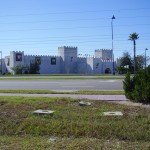 original town of Kissimmee is still there tucked away at the back of the main drag, but seen by few visitors to the area. The motel prices are closely geared to demand, and at the moment they are very low ($25 to $40 per night), because business is slack. It was much colder in Kissimmee than down south.
original town of Kissimmee is still there tucked away at the back of the main drag, but seen by few visitors to the area. The motel prices are closely geared to demand, and at the moment they are very low ($25 to $40 per night), because business is slack. It was much colder in Kissimmee than down south.
The next morning I visited another strange town, Celebration. At one time I used to say that Carmel in California, the town where Clint Eastwood used to be mayor, was the World Centre of Niceness. That was until I discovered Fernandina Beach, in north-eastern Florida, where the traffic in the main street stops if you look as if you might even be thinking of crossing the road, and the public lavatories are called Comfort Stations. It would be a good place for me to live, because I spend quite a lot of time nowadays trying to cross roads to get to Comfort Stations on the other side.
Anyway, Carmel and Fernandina Beach have evolved into what they are, but Celebration was a carefully planned attempt in 1994 by the mighty Disney Corporation to create an idyllic town where people can live in perfect happiness. The buildings are a mixture of traditional American architectural styles, and are generally of high quality construction. In the centre there are shops, civic buildings, a church, post office and a marvellous slightly over the 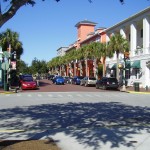 top art deco cinema, along with tree-lined avenues and a lake. It is like a larger American version of Poundbury, and I am sure Prince Charles would love it. To enable the residents to top up their innocence with minimal exposure to the evils of the outside world there is even a direct route into the main Disney complex. Whether they live in perfect happiness I cannot say, but at least they have lives, which is more than can be said for the people of Rotonda.
top art deco cinema, along with tree-lined avenues and a lake. It is like a larger American version of Poundbury, and I am sure Prince Charles would love it. To enable the residents to top up their innocence with minimal exposure to the evils of the outside world there is even a direct route into the main Disney complex. Whether they live in perfect happiness I cannot say, but at least they have lives, which is more than can be said for the people of Rotonda.
The original schedule I had for the return flight left me only an hour for the connection at Charlotte, and in view of the problems I had on the way out I had called in at Sarasota Airport and booked an earlier flight from Tampa which would give me three hours. I was frisked again in security at Tampa, but otherwise things went very smoothly and I had plenty of time. Internal flights in the USA are routine for a lot of people, and on the plane there was a boy with a skateboard and the lady next to me had an 11-week-old unnamed white poodle on her lap in a soft bag with mesh sides. It slept for most of the flight.
The main hall in the terminal at Charlotte was the best I have seen anywhere. There was a man playing honky-tonk music on a piano, and along the side were white wooden rocking chairs. The whole place was beautifully laid out with plants and large model aircraft hanging from the ceiling, decorated for Christmas. The rocking chairs were in great demand, but I managed to get one for about half an hour and rocked the whole time. There were also brightly coloured bean bags like large dogs' beds, all of which were occupied by bearded young men who looked as if they spent their whole lives travelling around the world.
In the departure lounge I got talking to a lady named Brenda who lives near Gatwick. Bits of information were coming through about the weather in England. It was supposed to have taken someone 6 hours to get from Uckfield to East Grinstead, and people were said to have been kept on a plane at Gatwick for 5 hours.
The flight departed on time. On the return flight from the States I can usually get some sleep, but this time all I managed was about 5 minutes before I was hit on the shoulder by a trolley, and a cup of coffee and something called a Danish were put in front of me. Now, Danish is an adjective, and it was not followed by a noun, probably because no one could think of one to apply to the object in question. It was like a slab of warm, soft plastic wrapped in greaseproof paper, and would have put anyone off Denmark for ever. I ate it, of course, because it was free.
When we were about an hour from Gatwick the captain announced that we were being diverted to Glasgow, where we landed at 7.30am. The captain said we should stay in the plane in the hope that we could go on to Gatwick before too long. There were some people from Glasgow on the plane, but the captain said they could not get off for security reasons, and would have to go to Gatwick and come back.
After about ½ hour the ground power supply was cut off, which meant that the ventilation stopped. Where I was sitting, near the open door at the front it was ok, actually slightly cold, but where the toilets were half way along it was quite warm, and at the back it must have been stifling. From time to time the captain said he was trying to make arrangements for us to leave the plane and go into a holding area without going through immigration, until we could fly on. After another 2½ hours in the plane some children at the back started to be ill, and paramedics were called. After examining the children they went to see the captain, and soon afterwards we were deplaned, as the Americans say. I believe a baby was taken to hospital.
Immigration was quite quick, but Brenda and I had to wait a long time for our bags. I had one large heavy bag, and Brenda, of course, had two. We were told to go to the Serviceair desk. By the time we got to the main hall there was a queue like a huge mushroom with 4 people at the Serviceair desk across the bottom of the stalk. With me pushing the trolley and Brenda in charge of operations we got to the desk in 45 minutes, half the time it would have taken me on my own.
At the Serviceair desk we were allocated rooms in the Holiday Inn, across the road, with lunch, dinner and breakfast paid for. We were told that there would be a flight to Gatwick the next day. It was now about 12.30, five hours after we had landed.
At lunchtime I sat with Brenda and two other ladies, and I said that as I had never been to Glasgow before and would probably never come again I would like to get a bus into the city and have a look round. It did not enter my head that I had been up for 25 hours at this point. Brenda said she had always imagined herself walking down Sauchiehall Street, so we went in on the 500 Flyer. In the city centre it was fine but very cold, and there was some ice on the pavements. We had a good look round, and Brenda arranged for us to use the toilets in the offices of an insurance company that we had mistaken for an art gallery. Along the way we spoke to quite a few people, and they were all very pleasant and helpful, though difficult to understand. I had not realised how steep some of the streets in the middle of the city were, with level bits and sudden drops like those in San Francisco.
At dinner time we were told to be up for breakfast in the morning at 6.15 and in the airport by 7.00. On top of the television I found a card explaining how to use it as an alarm clock, and with the remote control I set it, hopefully, for 5.30am. I actually woke at about 4.00 and shortly before 5.30 I was sitting bolt upright in bed with my eyes glued to the TV to see what would happen. Sure enough, at exactly 5.30 it started buzzing, and then the screen burst into life with a picture of Gordon Brown leaving 10 Downing Street. Not for the last time, unfortunately.
At 7.00 we were in the airport, and joined a queue to check in for our flight. After ½ hour the queue had hardly moved at all, and I went up to find out what was happening. It turned out that some people did not have documents to prove that they were on the previous day's flight, and the people at the desk did not have a passenger list. They were putting separate calls for each passenger through to US Airways in the States, where it was 2am, to confirm whether the person concerned should be on the flight. A well-spoken young black bloke suggested that perhaps they could get a passenger list faxed from the States, but that idea was dismissed out of hand. After 1¾ hours we finally got our bags checked in. In the course of all this we were told that our flight would be at 12.30.
The flight information listed on the screens was vague, but there was a suggestion that our flight would depart from gate 33, and that is where everyone eventually congregated. There was a US Airways plane standing at the gate. The gate indicator said Flight 732 London Gatwick. It got to about 12 o'clock and nothing was happening. People were asking the airport staff, who did not know anything, but we were told that someone would come to see us shortly. The desk remained unmanned. From time to time the phone rang and was answered by the waiting passengers, who tried to engage in conversation with the callers. The indicator suddenly changed to Flight 732 Philadephia. A deputation of people went to the airport manager's office to try to get some information. Then a US Airways pilot in full regalia made the great mistake of walking through the middle of the throng. He was waylaid and eventually agreed to make a phone call to find out what was happening. He said someone would come to see us shortly. Some people were now getting quite wound up. Eventually the airport authorities did respond to the complaints - they sent two policemen. Unfortunately it is now easier for people working at airports to send in the police to deal with complaints rather than to do their jobs properly by keeping people informed.
Soon afterwards the pilot returned, followed by a man from Serviceair, the company contracted to handle the US Airways flight. The pilot said he was taking the plane to Philadelphia, and the Gatwick flight was cancelled. He said planes were only getting into Gatwick at 2 per hour, with preference for BA, and US Airways were getting no slots at all. The Serviceair man said we should collect our bags and go to the Serviceair desk. Brenda disappeared in the throng of people moving towards the main part of the terminal, and I found myself in a group of about 20 people, following a fat lady who led us on a tortuous route through the bowels of the airport. When we got to the baggage hall the fat lady did not sing, so I assumed that there was more misery to come. The bags, about 450 of them, had been taken off the conveyor and were spread all over the floor. I was still looking for Brenda's second case when she turned up from somewhere and identified it. We got another trolley and went to the Serviceair desk, where we were told that coaches would be provided to take us to Gatwick. These would be free and take 9 hours. If we wished to make other arrangements we could, but we would have to pay for them. One man was repeatedly shouting at the top of his voice that he wanted a hire car, with his wife standing behind him telling him to shut up or he would be arrested.
It was now almost 2.00pm, and I was in favour of going by train, because of the time factor, but after a brief discussion we decided to take the coach because it would avoid humping the luggage about (and also save at least £80).
By this time we had discovered that that day's incoming flight had also been diverted to Glasgow, so there were about 600 people trying to get to Gatwick. Just outside the terminal was a long line of coaches, with more coming all the time. It appears that airline passengers have more and larger bags than coach passengers, so by the time the luggage compartments were full the seats were only half filled. After a bit of a struggle we got sorted and after over 30 hours in  Glasgow we were on the way to Gatwick. The coach stopped twice at motorway services on the way, and the journey was not as bad as I expected. It was quite warm and comfortable, and the air quality was much better than in a plane. Brenda slept a lot of the time, and I went into a state of suspended animation apart from a couple of visits to the toilet while we were hurtling down the motorway at 70mph. Not something I would do from choice.
Glasgow we were on the way to Gatwick. The coach stopped twice at motorway services on the way, and the journey was not as bad as I expected. It was quite warm and comfortable, and the air quality was much better than in a plane. Brenda slept a lot of the time, and I went into a state of suspended animation apart from a couple of visits to the toilet while we were hurtling down the motorway at 70mph. Not something I would do from choice.
We got to Gatwick at 11.20pm. There was more snow there than anywhere on the way down. Fortunately I had left the van in the long stay car park, because the trains, which are subsidised from public funds to the tune of £5,000,000,000 per year, had stopped running at 9.30. The car park buses were still running every 10 minutes, and Brenda waited in the bus shelter with the cases while I sorted the van out. There was about 8in of snow in the car park, and the van, which had been there for 11 days, was joined to the metal barrier at the side by a block of frozen snow.
The van could not get a grip to climb up the slight incline leading to Brenda's house, and we had to carry her bags for the last 100 yards. After saying goodbye to her I set off for Bognor and arrived home at 1.57am on the Friday morning.
One of the many wise things that I have often said is that when you travel around in America you must be prepared to take the rough with the smooth. You will meet people you don't like and find yourself in places you don't like. This trip 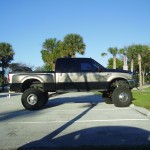 was an exception. Everyone I met was pleasant and although Yeehaw Junction and parts of Tampa were not places I would go out of my way to visit they were not dreadful. The weather was mostly bright, though sometimes cooler than I had hoped, and there was plenty of Americana, which in the end is what it is all about. It was in Britain that things really went wrong.
was an exception. Everyone I met was pleasant and although Yeehaw Junction and parts of Tampa were not places I would go out of my way to visit they were not dreadful. The weather was mostly bright, though sometimes cooler than I had hoped, and there was plenty of Americana, which in the end is what it is all about. It was in Britain that things really went wrong.
